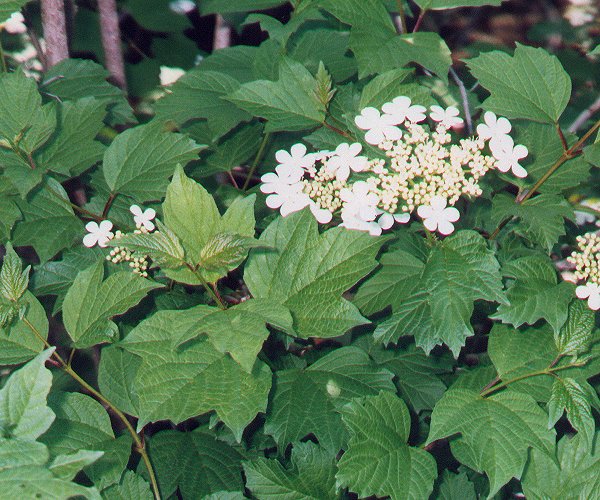Viburnum opulus L.
Guelder Rose

Introduced
CC = *
CW = 0
MOC = 4
© DETenaglia
Viburnum opulus L.Guelder Rose | |
 |
Introduced CC = * CW = 0 MOC = 4 |
© DETenaglia |
|
Family - Caprifoliaceae Habit - Shrub or small tree to 4 m tall. Stems - Woody, multiple or sometimes a single trunk. Twigs glabrous. Leaves - Opposite, petiolate, 3-lobed, margins toothed or sometimes entire, glabrous above, sparsely pubescent below. Petiole glabrous, to 3cm long.
Inflorescence - Terminal, flat-topped cymes. Compound and resembling umbels, to +13cm broad. Stalks glabrous to very sparsely pubescent.
Flowers - Outer flowers sterile, white, to 2.5cm broad, slightly irregular, 5-lobed. Inner flowers fertile. Corolla to 5mm broad, white, 5-lobed, externally glabrous, internally sparsely pubescent. Lobes rounded, 2mm broad, 1mm long. Corolla tube campanulate, 3mm broad, 1.7mm long. Stamens 5, alternating with corolla lobes, erect, well exserted beyond corolla. Filaments to 5mm long, white, glabrous. Anthers tan, .7mm long.
Fruits - Red, globose to subglobose, single-seeded (drupes), to 12mm in diameter, 15mm long.
Flowering - June - July. Habitat - Moist to wet soils of lake margins, slopes, or open woods. Also cultivated. Origin - Native to the U.S. and Europe. Lookalikes - None. The form of the plant known as var. opulus is the variety found growing wild here in the U.S. and pictured above. Other varieties from Europe are commonly cultivated across the U.S. Photographs taken at the Kansas City Zoo, 6-2-99, 5-1-00, and 10-16-99 (DETenaglia). |